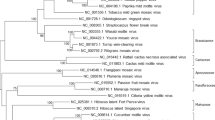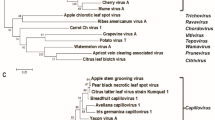Abstract
An isolate of the tentative carlavirus species Hydrangea chlorotic mottle virus (HdCMV) was found in New Zealand (NZ) in 2007. The host range, serological properties and complete genome sequence of this isolate were determined in this study. While the NZ isolate shared 98% nucleotide sequence identity with the US isolate of HdCMV, differences in titre and host range were found. The HdCMV-NZ genome sequence of 8,433 nt possessed a typical carlavirus organisation with six open reading frames. HdCMV is most closely related (60.4% nt identity) to blueberry scorch virus, a relationship also suggested by serology. These data suggest that HdCMV is a new carlavirus species.


Similar content being viewed by others
References
Adams AN, Barbara DJ (1982) Host range, purification and some properties of two carlaviruses from hop (Humulus lupulus): hop latent and American hop latent. Ann Appl Biol 101:483–494
Adams MJ, Accotto GP, Agranovsky AA, Bar-Joseph M, Boscia DAAB, Candresse T, Coutts RHA, Dolja VV, Falk BW, Foster GD, Gonsalves D, Jelkmann W, Karasev A, Martelli GP, Mawassi M, Milne RG, Minafra A, Namba SAR, Vetten HJ, Vishnichenko VK, Wisler GC, Yoshikawa N, Zavriev SK (2005) Flexiviridae. Virus Taxonomy, VIIIth Report of the ICTV Elsevier/Academic Press, London, pp 1089-1124
Allen TC, McMorran JP, Locatelli EA (1983) Isolation of Tomato spotted wilt virus from Hydrangea and four weed species. Plant Dis 67:429–431
Allen TC, McMorran JP, Lawson RH (1985) Detection and identification of viruses in Hydrangea. Acta Hortic 164:85–89
Badge J, Brunt A, Carson R, Dagless E, Karamagioli M, Phillips S, Seal S, Turner R, Foster GD (1996) A carlavirus-specific PCR primer and partial nucleotide sequence provides further evidence for the recognition of Cowpea mild mottle virus as a whitefly-transmitted carlavirus. Eur J Plant Pathol 102:305–310
Cavileer TD, Halpern BT, Lawrence DM, Podleckis EV, Martin RR, Hillman BI (1994) Nucleotide sequence of the carlavirus associated with blueberry scorch and similar diseases. J Gen Virol 75:711–720
Cerbah M, Morteau E, Brown S, Siljak-Yakolev S, Bertrand H, Lambert C (2001) Genome size variation and species relationships in the genus Hydrangea. Theor Appl Genet 103:45–51
Chiko AW, Godkin SE (1986) Occurrence of Alfalfa mosaic, Hydrangea ringspot, and Tobacco ringspot viruses in Hydrangea spp in British Colombia. Plant Dis 70:541–544
Choi SA, Ryu KH (2003) The complete nucleotide sequence of the genome RNA of Lily symptomless virus and its comparison with that of other carlaviruses. Arch Virol 148:1943–1955
Cohen J, Zeidan M, Rosner A, Gera A (2000) Biological and molecular characterisation of a new carlavirus isolated from an Aconitum sp. Phytopathology 90:340–344
Hataya T, Uchino K, Arimoto R, Suda N, Sano T, Shikata E, Uyeda I (2000) Molecular characterisation of Hop latent virus and phylogenetic relationships among viruses closely related to carlaviruses. Arch Virol 145:2503–2524
Hill SA (1984) Methods in plant virology. Blackwell, Oxford
Koonin EV, Dolja VV (1993) Evolution and taxonomy of positive-strand RNA viruses: implications of comparative analysis of amino acid sequences. Crit Rev Biochem Mol Biol 28:375–430
Lawson RH (1995) Hydrangea. In: Loebenstein G, Lawson RH, Brunt AA (eds) Virus and virus-like diseases of bulb and flower crops. Wiley, Chichester, pp 482–492
Li R, Mock R (2008) Characterisation of a flowering cherry strain of Cherry necrotic rusty mottle virus. Arch Virol 153:973–978
Machado Caballero JE, Lockhart BE, Mason SL, Daughtrey M (2009) Identification and properties of a carlavirus causing chlorotic mottle of florists’ hydrangea (H. macrophylla) in the United States. Plant Dis 93:891–895
Martin DP, Williamson C, Posada D (2005) RDP2: recombination detection and analysis from sequence alignments. Bioinformatics 21:260–262
Milne RG, Djelouah K, Garcia JA, Dal Bo E, Grau O (1996) Structure of citrus ringspot psorosis virus associated particles: Implications for diagnosis and taxonomy. In: Proceedings of the 13th Conference of the International Organisation of Citrus Virologists, pp 189-197
Rozanov MN, Koonin EV, Gorbalenya AE (1992) Conservation of the putative methyltransferase domain: a hallmark of the ‘Sindbis-like’ supergroup of positive-strand RNA viruses. J Gen Virol 73:2129–2134
Scott SW, Zimmermann MT, Ge X (2003) Viruses in subgroup 2 of the genus Ilarvirus share both serological relationships and characteristics at the molecular level. Arch Virol 148:2063–2075
Scott SW, Zimmermann MT (2008) The complete sequence of Ligustrum necrotic ringspot virus, a novel carlavirus. Arch Virol 153:393–396
Spiegel S, Zeidan M, Sobolev I, Beckelman Y, Holdengreber V, Tam Y, Bar-Joseph M, Lipsker Z, Gera A (2007) The complete nucleotide sequence of Passiflora latent virus and its phylogenetic relationship to other carlaviruses. Arch Virol 152:181–189
Tamura K, Dudley J, Nei M, Kumar S (2007) MEGA4: Molecular Evolutionary Genetics Analysis (MEGA) software version 4.0. Mol Biol Evol 10:1093
Thomas BJ, Barton RJ, Tuszynski A (1983) Hydrangea mosaic virus, a new ilarvirus from Hydrangea macrophylla (Saxifragaceae). Ann Appl Biol 193:261–270
van der Vlugt RAA, Berendsen M (2002) Development of a general Potexvirus detection method. Eur J Plant Pathol 108:367–371
Acknowledgments
The authors wish to thank Dr. Ben Lockhart for kindly providing the antiserum against the US isolate of Hydrangea chlorotic mottle virus. We also thank Dr. Francisco Ochoa-Corona for locating and collecting the HdCMV-infected samples.
Author information
Authors and Affiliations
Corresponding author
Rights and permissions
About this article
Cite this article
Tang, J., Harper, S.J., Wei, T. et al. Characterization of hydrangea chlorotic mottle virus, a new member of the genus Carlavirus . Arch Virol 155, 7–12 (2010). https://doi.org/10.1007/s00705-009-0541-3
Received:
Accepted:
Published:
Issue Date:
DOI: https://doi.org/10.1007/s00705-009-0541-3




